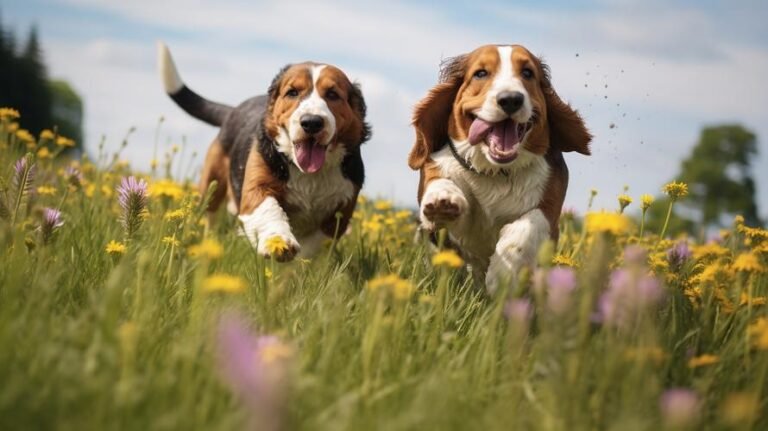Imagine a dog with a beard that rivals a wise wizard and a gaze filled with an ancient lineage of hunting prowess. Now, add to that image a wagging tail, perked-up ears, and an unyielding zest for life. You have now pictured the Petits Bassets Griffons Vendéen, affectionately known as the PBGV. This small yet mighty hound has an ancestry deeply rooted in the Vendée region of France, where they sniffed out everything from rabbits to wild boar.
Now, as captivating as these clever canines are, the question begs to be answered: “How trainable is this bearded charmer?” The answer is not straightforward. Training a PBGV can be much like teaching a toddler to eat with utensils. It’s doable, but it requires patience, creativity, and understanding their whimsical nature.
Understanding the PBGV
In order to dive into their training abilities, we must first understand what makes the PBGV tick. Bred for hunting, they possess an extraordinary sense of smell and an innate desire to follow scents. This trait makes for a fantastic hunting partner in the field, yet can be a point of contention during training sessions when smells compete for your PBGV’s attention.
Let’s not forget the independence factor. PBGVs are thinking dogs; they are independent problem-solvers who can be stubborn. So, when it comes to training, traditional submissive obedience is not in their vocabulary. Instead, we must tap into what motivates them—more often than not, it’s food, fun, and a frolicsome challenge.
Starting Off on the Right Paw
Training this vivacious Vendéen begins with patience and the building of a strong relationship. If your PBGV respects and trusts you, you have won half the battle. Early socialization is critical—exposing puppies to various sights, sounds, and experiences shapes them into well-rounded dogs. This social foundation cannot be underestimated when we later expect them to focus amidst a bouquet of tantalizing scents and distractions.
Tackling the Training
Positive reinforcement is the secret sauce in training a PBGV. Yelling or harsh corrections can damage your rapport and send your dog’s ears and interest in the opposite direction. Instead, reward good behavior with treats and praise—celebrate the victories, even if they initially seem minor.
Consistency is king. Whether you’re house training or teaching your PBGV to sit, developing a consistent routine is vital. Remember, repetition is not drudgery but clarity in the canine world.
Instilling Obedience
When it comes to basic commands like ‘sit’, ‘stay’, or ‘come’, the PBGV might showcase their independent streak. However, this does not mean they are incapable of learning. These commands must be made entertaining, and more importantly, they should lead to something rewarding. If ‘come’ always leads to the end of playtime, the PBGV quickly learns that ‘come’ is a four-letter word. Hence, always mix commands with positive outcomes—‘come’ should sometimes lead to a game, a treat, or affection.
Harnessing their Hunting Instinct
Their strong hunting instinct can be both a hurdle and a help in training. While it may lead them astray during training sessions, redirecting this drive can boost their engagement. Consider scent games or tracking activities which not only hone their skills but also satisfy their intrinsic desires.
The Art of Compromise
Training a PBGV often involves a degree of negotiation. You want them to heel, but they smell something far more interesting. Instead of a battle of wills, find a balance. Allow them a moment to sniff, then call them back to the task at hand. Show them that listening to you doesn’t mean the end of fun—it’s simply a pause button.
Choosing the Right Training Approach
Group obedience classes can be a double-edged sword. While providing essential socialization, they can also lead to sensory overload for your PBGV. Carefully gauge how your dog is handling the experience. Private lessons might cost more but can provide tailored tactics that suit your PBGV’s unique personality.
Trail and Error: Training Tactics
What works for one PBGV may not work for another. One may respond excellently to clicker training, while another may find the sound as appealing as a vacuum cleaner. Some may be food motivated, while others may do anything for a squeaky toy. Finding what makes your PBGV ‘tick’ will require a bit of detective work, but when you discover it, training becomes significantly smoother.
The Need for Mental Stimulation
PBGVs are brainy and require mental stimulation to prevent boredom—which can lead to destructive behavior. Training should not only be about obedience but also about keeping their minds active.
Conclusion
In conclusion, while PBGVs may not be the easiest breed to train due to their independent nature and distractibility, they are far from untrainable. With a strong foundation of trust, consistent and positive training practices, and a willingness to make learning fun and rewarding, your PBGV will not only learn but thrive.
Remember, despite all the training in the world, your PBGV will still have moments of whimsical rebellion. They are, after all, creatures of charm and charisma who weave joy into their every movement. Embrace those quirks, for they are the enchanting threads that make the tapestry of the Petits Bassets Griffons Vendéen.



